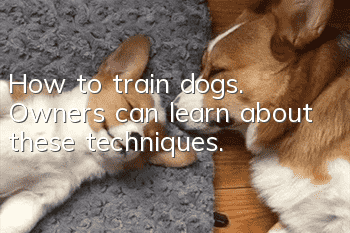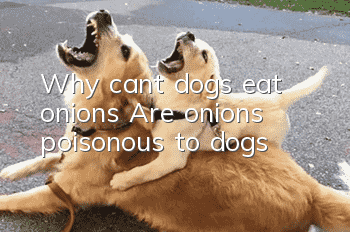How to train dogs. Owners can learn about these techniques.

Training dogs is about timing
When using a positive approach, the timing of corrections and rewards is the most critical element.
Rewards need to be given at the right time to ensure the dog associates the correct behavior with the reward. For example, if you are practicing sitting instruction with your dog, the correct approach is to reward the dog when the legs and hips are completely on the ground. If you mistakenly reward your dog for standing up, he will mistakenly think you are rewarding him for standing up instead of sitting down.
Using a training tool (clicker) that makes a sound to mark reward moments can help you seize the opportunity during training.
Dog training instructions should not be too long
Dog training instructions should not be too long. It is best to use one word or sound to represent an action. Dogs cannot understand a series of actions put together as a command. For example, if you say to your dog, "I want you to sit down, can you?" The dog may not react in any way. Keep your commands short so they don't sound complicated to your dog. The more commonly used instructions include:
watch me
Stay
Lie (down)
Sit
stand
Come
Follow (heel)
Leave it
It is important to keep behaviors and standards consistent
Every member of the family should use the same commands so that there is no confusion when the dog learns and follows the commands. Helps with dog training.
When to use positive methods
The right way: Positive methods are very effective in training dog commands, and it is also a method to reinforce correct behavior.
You can reinforce the good behavior of "sitting" by asking your dog to "sit" before doing the following things (which are equivalent to rewards for the dog):
Before the dog goes out (to prevent the dog from rushing out of the house crazily after opening the door)
Before petting the dog (to prevent the dog from jumping towards people)
Before feeding the dog (teaching the dog the correct behavior when eating)
When your dog lies quietly next to you, pat him or give him a verbal reward.
Wrong approach: Be careful not to reward unwanted behavior in a positive way without realizing it. For example, if you have a dog that barks at your neighbors, choose to take the dog outside. In the process, you reward the dog for barking at the neighbor.
Gradually formedBehavior (Shaping)
Learning certain behaviors may take a longer time. You may use the "shaping" method, which means that during the training process, you will first reward certain actions that are similar to the desired behavior, and then gradually guide the dog with food to increase the standard for obtaining rewards. So that it can eventually learn a certain behavior. For example, if you want to train your dog to "shake hands", you need to reward the dog first by lifting its front paws from the ground, then you can hold the dog's front paws, and finally "shake hands" with you.
Types of rewards
Rewards used in positive methods can include food rewards, verbal rewards, petting, favorite toys or game interactions. Because most dogs cannot resist the temptation of delicious food, using food as a reward during training will have good results.
The food used during training needs to meet the following characteristics:
1. It should be very delicious for dogs and have irresistible temptation;
2. It can be easily divided into small pieces by hand. For smaller dogs, the food even needs to be divided into pea-sized pieces;
3. Dogs cannot eat it at ordinary times and only use it during training;
4. The texture is soft and the dog does not need to chew too much. It can eat quickly and then train. If the dog eats for a long time, it will inevitably affect the continuity of training;
5. Do not choose food that will drop residue during chewing. The dog will lower his head to lick the food on the ground while eating, and it will also take a long time, affecting the continuity and progress of training;
p>Prepare several different training foods to prevent your dog from getting bored with certain foods. You can process these foods and put them in ziplock bags. Each time you use a food reward, also say the verbal reward in an excited voice, such as, "You're great," "Good boy."
If your dog is not motivated enough to reward you with food, you can try using petting, toys, or games as rewards. However, it should be noted that using other forms of non-food rewards will make training more difficult because each reward will take longer.
When to reward your dog with food
When your dog learns a new skill, reward it with food every time it repeats the skill in its life. This reward process has a continuous reinforcing effect on learned behaviors. Once the new skill has established a stable conditioned firing in your dog's behavior, you can stop giving rewards every time and instead give them intermittently, gradually reducing the frequency of food rewards. At the beginning, the dog was rewarded 4 times for every 5 times he did it. After a while, reward 3 out of 5 times, then 2 times, and finally just the occasional food reward. Every time your dog does something you command or want, reward him verbally or pet him. in differentTime and place, practice new skills, and ultimately enable the dog to successfully complete the behavior at any time and in any complex environment.
Note: Do not taper off the food reward too quickly. If done too quickly, the dog will become frustrated. By understanding and mastering positive training methods, you don’t need to go out with a large bag of training food at all times. Instead, you only need to give verbal rewards and petting after the dog does the behaviors you require and hope, and occasionally give food rewards. Just consolidate it.
- What is normal for dogs to have eye mucus? How to deal with excessive eye mucus in dogs
- How to build trust with your dog and teach you tips on how to live in peace with your dog
- How to cut a dog's hair? Do you know the order of cutting a dog's hair?
- Things to note when fostering a dog. Teach you how to choose a fostering place.
- What is gastric torsion in dogs? What causes gastric torsion in dogs?
- Why are Huskies so popular? How much do you know about the advantages of Huskies?
- How to potty and urinate your dog? Gentleman’s Dog Training Manual
- What should dogs pay attention to in their winter diet? Owners should pay attention to these aspects
- What should I do if my dog disobeys me? Can I beat it?
- How to raise a Golden Retriever? Can you eat this basic knowledge? You couldn’t be more wrong!



